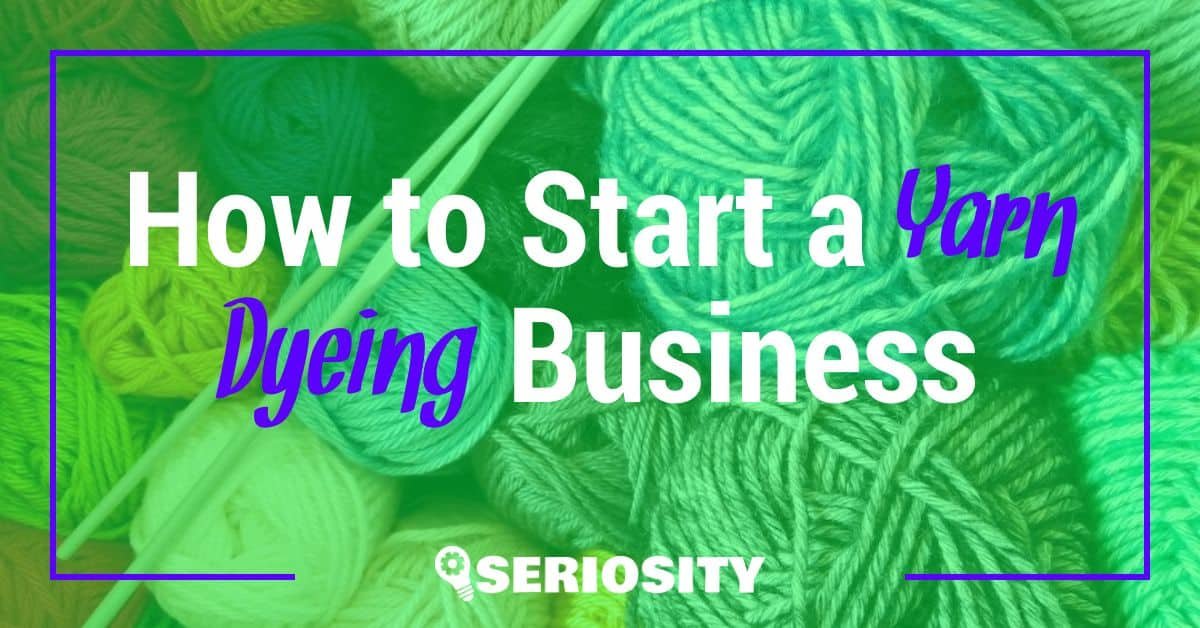Starting a yarn dyeing business is an exciting opportunity for creatives and entrepreneurs alike. As knitting, crocheting, and other fiber arts gain popularity, many artisans seek out unique, hand-dyed yarns to make their projects truly one-of-a-kind. With hard work, passion, and a bit of business savvy, you can turn your love for fiber arts into a thriving enterprise.
The success of a yarn dyeing business heavily relies on establishing a niche market and crafting a unique brand that stands out from competitors. This makes identifying your target audience, brand vision, and selecting high-quality materials crucial to building a strong foundation for your business. Furthermore, learning the ins and outs of dyeing techniques and understanding the importance of various materials will greatly contribute to your venture’s long-term sustainability.
In the following sections, we will delve deeper into the process of starting a yarn dyeing business, exploring essential topics including ideation, branding, marketing strategies, and supply chain management. By following these guidelines, aspiring entrepreneurs can set the stage for a highly successful hand-dyed yarn operation.
Understanding Yarn Dyeing
Yarn dyeing is a creative process that involves applying color to yarn in various techniques to achieve unique and vibrant results. It provides knitters and crocheters with a wide range of color options to make their projects stand out. In this section, we will explore different dyeing methods, colorways, and patterns that you can use to start your yarn dyeing business.
Dyeing Methods
There are several methods for dyeing yarn, each with its unique advantages and results. These methods include:
- Kettle dyeing: This method involves placing yarn in a dye bath (usually a large pot or container) and heating it to absorb the dye. Kettle dyeing results in yarn with subtle tonal variations.
- Hand-painting: This technique involves painting the dye directly onto the yarn using brushes or syringes. It allows for more control in creating patterns and color combinations.
- Speckling: This method uses small amounts of dye applied directly to the yarn to create a speckled effect. It is often combined with other techniques for a more complex final product.
- Dip dyeing: In this method, the yarn is partially submerged in the dye bath, resulting in a gradient effect.
Colorways and Patterns
The choice of color combinations and patterns in yarn dyeing can define the uniqueness of your business. Here are some common options:
- Solid colors: These yarns have a single, even color throughout. They can be achieved by kettle dyeing or other methods that allow for even color distribution.
- Tonal variations: These yarns have subtle shifts in color intensity, often resulting from kettle dyeing. These variations can add depth and interest to the final knitted or crocheted piece.
- Variegated: These yarns have two or more colors that repeat in a pattern. They can be created by hand-painting or other methods that allow for more control over color placement.
- Gradient: These yarns smoothly transition from one color to another, often achieved through dip dyeing or hand-painting.
It is essential to experiment with different dyeing techniques, colorways, and patterns to find what sets your yarn dyeing business apart from others. By offering a diverse range of options, you can cater to various tastes and project types. Furthermore, developing your unique style and product line will help your business stand out in the market.
Setting up Your Business
Startup Costs
Starting a yarn dyeing business requires an initial investment in materials and equipment. Here is a general list of necessary startup costs:
- Yarn: $300 – $500 (depending on the amount and quality)
- Dyes: $100 – $200
- Equipment (pots, scales, gloves, etc.): $100 – $200
- Workspace setup: $200 – $300
- Marketing materials (business cards, packaging, etc.): $100 – $150
In total, you can expect to spend around $800 – $1350 to start your yarn dyeing business.
Naming Your Business
Choosing the right name for your yarn dyeing business is essential, as it reflects your company’s identity and helps you stand out from competitors. Consider the following tips when coming up with a name:
- Keep it short and memorable
- Make sure it’s easy to pronounce and spell
- Verify that the domain name is available for your website
- Check if the name is available for registering as a business
- Reflect the nature of your business and the products you sell
Once you have settled on a suitable name, register it and proceed to create your website.
Creating a Website
When setting up a website for your yarn dyeing business, consider the following steps:
- Choose a platform like Shopify, WooCommerce, or Squarespace for easy setup and customization.
- Register your domain name, and set up professional email accounts.
- Design your website’s layout and appearance, keeping in mind user experience and brand consistency.
- Add high-quality product photographs and descriptions, as well as helpful information about your yarn dyeing process and any special techniques used.
- Set up payment gateways and shipping options, making sure to keep customer convenience in mind.
- Promote your website using social media, email marketing, and other means to attract potential customers.
By following these steps and investing in your startup costs, you will be well on your way to launching a successful yarn dyeing business.
Sourcing, Storing, and Pricing Yarn
Selecting the Right Yarn
When starting a yarn dyeing business, it’s crucial to select the right yarn for dyeing. Typically, yarns with higher natural fiber content, such as wool or alpaca, are better suited for dyeing. These fibers absorb the dye well and result in vibrant, long-lasting colors.
- Identify and research different yarn types and their characteristics for dyeing
- Reach out to manufacturers or wholesalers for yarn sourcing
- Consider the diversity of weights and textures to cater to different customers’ needs
Storage Solutions
Storing your yarn appropriately is essential for maintaining its quality and preventing damage. Here are some storage solutions to keep in mind:
- Utilize clear, plastic bins or tubs with lids to protect yarn from dust, light, and pests
- Organize yarn by color, weight, or fiber type for easy access
- Keep a dry, well-ventilated area dedicated to yarn storage
- Avoid extreme temperatures and high humidity levels
Pricing and Markup
Pricing your hand-dyed yarns accurately is a critical aspect of running a profitable yarn business. Your prices should cover the cost of materials, labor, and other business expenses, while also providing a reasonable profit margin.
- Research prices of similar hand-dyed yarns in the market
- Factor in your material and labor costs
- Determine a fair markup percentage that balances affordability and profitability
- Adjust prices periodically based on changes in material costs, market trends, and customer feedback
By carefully selecting the right yarn, implementing appropriate storage solutions, and setting competitive prices, you’ll lay a solid foundation for a thriving hand-dyed yarn business.
Marketing Your Yarn Dyeing Business
Online Platforms
Utilizing online platforms is crucial for the growth of your yarn dyeing business. Start by creating an online shop on popular e-commerce websites like Etsy, where you can showcase your hand-dyed yarn products and reach a larger customer base. Here are some steps:
- List your products with clear descriptions and high-quality images.
- Ensure your shop has a consistent branding and theme.
- Regularly update your inventory and add new products.
Additionally, create a website to provide more information about your business, yarn dyeing process, and other relevant content such as tutorials, articles, and blog posts. This will help establish your expertise and attract more customers.
Social Media
Leveraging social media platforms is essential for promoting your yarn dyeing business and connecting with the knitting community. Some popular channels to use are:
- Instagram: Share images of your dyed yarns, works-in-progress, and finished projects. Use relevant hashtags and engage with other users to grow your followers.
- Facebook: Create a business page and join related knitting and yarn-dyeing groups to share your products and engage with potential customers.
- Pinterest: Pin images of your products and projects from your website, Etsy shop, or other platforms to help drive traffic and gain a following.
Regularly post engaging and relevant content, such as tips and tutorials, to keep your audience interested and involved.
Networking and Community Involvement
Networking and community involvement can help expand your yarn dyeing business. Here are some ways to get involved:
- Attend local knitting or craft events, such as workshops and yarn swaps, to connect with potential customers.
- Build relationships with local yarn shops or knitting groups that might be interested in your hand-dyed products.
- Collaborate with other artists and crafters for unique projects or joint promotions.
- Participate in online forums, discussions, and communities related to knitting and yarn dyeing. Offer helpful advice and support while sharing your business information when relevant.
In conclusion, marketing your yarn dyeing business involves a combination of online platforms, social media channels, and networking within the knitting community. The key is to consistently engage with customers, build relationships, and showcase your unique hand-dyed yarn products.
Planning for Growth and Sustainability
Adapting to Change
In the dynamic world of the yarn dyeing industry, it’s essential to be adaptable to change. As a hand dyer, you’ll face challenges in the form of new dyeing techniques, changing market demands, and fluctuating costs of materials.
- Dedicate time for research and staying informed about industry trends to keep your business relevant
- Be open to modifying your dyeing processes, techniques, and even your product offerings
- Embrace new technologies and environmentally-friendly dyeing methods, such as sustainable textile dyeing, to stay competitive
Personal Development as a Business Owner
Personal growth and learning are crucial aspects for the success of any business owner. In the yarn dyeing industry, the journey of the hand dyer involves staying current with market trends, refining dyeing techniques, and nurturing creativity.
- Allocate hours for personal development each week, such as attending workshops or taking online courses
- Approach challenges as opportunities for growth and improvement
- Strive to be a lifelong learner to stay ahead of the competition and offer your customers the best product possible
Creating a Strong Customer Base
A loyal and satisfied customer base is essential for the sustainability and growth of your yarn dyeing business. Building strong relationships with your customers will fuel success in the long run.
- Ensure that your products are of the highest quality, adhering to colorfastness and durability standards
- Provide responsive and exceptional customer service to handle inquiries and resolve issues
- Utilize social media and other marketing tools to connect with potential customers, showcase your work, and engage with the community
By incorporating these strategies into your business plan, you’ll be well-positioned for growth and sustainability in the yarn dyeing industry.
How to Dye Yarn Naturally
Materials and Tools
To dye yarn naturally, you will need the following materials and tools:
- Yarn: wool, silk, or other natural fibers
- Natural dye source: plants, flowers, fruits, vegetables, or other natural materials
- Large pot or container for dyeing
- Strainer or cheesecloth
- Gloves and apron to protect hands and clothes
- pH testing strips (optional)
Dyeing Process
Follow these steps to dye yarn naturally:
- Prepare the yarn: Unwrap the yarn from the ball, loosely coil it into a large loop, and secure it with smaller pieces of string to ensure even dye distribution.
- Extract the dye: Chop the natural dye source (e.g., plant material) into small pieces, place it in a large pot or container, and cover with water. Heat the mixture until it reaches a simmer, and continue simmering for approximately one hour. Strain the dye liquid to remove any debris.
- Mordant the yarn (optional): Mordanting, or treating the yarn with a chemical to make it more receptive to dye, may improve colorfastness. Some natural dyes may not require mordanting. If you choose to mordant the yarn, follow the appropriate mordanting process for your chosen dye source.
- Dye the yarn: Soak the yarn in warm water, then immerse it completely in the dye liquid. Heat the mixture until it reaches a simmer and continue simmering for approximately one hour. You can experiment with color intensity by adjusting the length of time the yarn is immersed in the dye.
- Rinse and dry: Once the yarn has reached the desired color, remove it from the dye, squeeze out the excess liquid gently, and rinse it in lukewarm water until the water runs clear. Finally, hang the yarn to dry.
Safety and Environmental Considerations
When dyeing yarn naturally, it is essential to consider safety and environmental concerns. Keep the following points in mind:
- Wear gloves and an apron to protect your hands and clothes from dye stains.
- Work in a well-ventilated area to avoid inhaling any fumes from the dye sources.
- Dispose of dye waste responsibly. Many natural dyes are biodegradable and can be safely added to compost, but it is essential to check the specific disposal instructions for your chosen dye source.
- Dyeing yarn naturally can be an eco-friendly and sustainable way to create beautifully colored yarn while minimizing the use of chemicals.
By following these steps and guidelines, you can start a yarn dyeing business that focuses on naturally dyed yarns, offering a unique and environmentally friendly product in the growing market for handmade and sustainable fiber arts.





